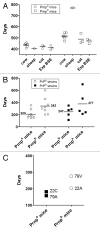Implications of prion polymorphisms
- PMID: 23807178
- PMCID: PMC3904311
- DOI: 10.4161/pri.25566
Implications of prion polymorphisms
Abstract
The sequence of a host's prion protein (PrP) can affect that host's susceptibility to prion disease and is the primary basis for the species barrier to transmission. Yet within many species, polymorphisms of the prion protein gene (Prnp) exist, each of which can further affect susceptibility or influence incubation period, pathology and phenotype. As strains are defined by these features (incubation period, pathology, phenotype), polymorphisms may also lead to the preferential propagation or generation of certain strains. In our recent study of the mouse Prnp(a) and Prnp(b) polymorphisms (which produced the proteins PrP(a) and PrP(b), respectively), we found differences in aggregation tendency, strain adaptability and conformational variability. Comparing our in vitro data with that of in vivo studies, we found that differing incubation periods between Prnp(a) and Prnp(b) mice can primarily be explained on the basis of faster or more efficient aggregation of PrP(a). In addition, and more importantly, we found that the faithful propagation of strains in Prnp(b) mice can be explained by the ability of PrP(b) to adopt a wider range of conformations. This adaptability allows PrP(b) to successfully propagate the structural features of a seed. In contrast, Prnp(a) mice revert PrP(b) strains into PrP(a) -type strains, and overall they have a narrower distribution of incubation periods. This can be explained by PrP(a) having fewer preferred conformations. We propose that Prnp polymorphisms are one route by which certain prion strains may preferentially propagate. This has significant implications for prion disease, chronic wasting disease (CWD) in particular, as it is spreading through North America. Deer which are susceptible to CWD also carry polymorphisms which influence their susceptibility. If these polymorphisms also preferentially allow strain diversification and propagation, this may accelerate the crossing of species barriers and propagation of the disease up the food chain.
Keywords: adaptation; aggregation; amyloid; kinetics; mouse; polymorphism; prion; propagation; species barrier; strain.
Figures

Comment on
-
Mouse prion protein polymorphism Phe-108/Val-189 affects the kinetics of fibril formation and the response to seeding: evidence for a two-step nucleation polymerization mechanism.J Biol Chem. 2013 Feb 15;288(7):4772-81. doi: 10.1074/jbc.M112.414581. Epub 2013 Jan 2. J Biol Chem. 2013. PMID: 23283973 Free PMC article.
Similar articles
-
Mouse prion protein polymorphism Phe-108/Val-189 affects the kinetics of fibril formation and the response to seeding: evidence for a two-step nucleation polymerization mechanism.J Biol Chem. 2013 Feb 15;288(7):4772-81. doi: 10.1074/jbc.M112.414581. Epub 2013 Jan 2. J Biol Chem. 2013. PMID: 23283973 Free PMC article.
-
Deer Prion Proteins Modulate the Emergence and Adaptation of Chronic Wasting Disease Strains.J Virol. 2015 Dec;89(24):12362-73. doi: 10.1128/JVI.02010-15. Epub 2015 Sep 30. J Virol. 2015. PMID: 26423950 Free PMC article.
-
First report of a strong association between genetic polymorphisms of the prion protein gene (PRNP) and susceptibility to chronic wasting disease in sika deer (Cervus nippon).Transbound Emerg Dis. 2022 Sep;69(5):e2073-e2083. doi: 10.1111/tbed.14543. Epub 2022 Apr 9. Transbound Emerg Dis. 2022. PMID: 35349210
-
Cervid Prion Protein Polymorphisms: Role in Chronic Wasting Disease Pathogenesis.Int J Mol Sci. 2021 Feb 25;22(5):2271. doi: 10.3390/ijms22052271. Int J Mol Sci. 2021. PMID: 33668798 Free PMC article. Review.
-
Structural factors underlying the species barrier and susceptibility to infection in prion disease.Biochem Cell Biol. 2010 Apr;88(2):195-202. doi: 10.1139/o09-172. Biochem Cell Biol. 2010. PMID: 20453922 Review.
Cited by
-
The role of the unusual threonine string in the conversion of prion protein.Sci Rep. 2016 Dec 16;6:38877. doi: 10.1038/srep38877. Sci Rep. 2016. PMID: 27982059 Free PMC article.
-
Variation in the vulnerability of mice expressing human superoxide dismutase 1 to prion-like seeding: a study of the influence of primary amino acid sequence.Acta Neuropathol Commun. 2021 May 20;9(1):92. doi: 10.1186/s40478-021-01191-w. Acta Neuropathol Commun. 2021. PMID: 34016165 Free PMC article.
-
Strain phenomenon in protein aggregation: Interplay between sequence and conformation.Intrinsically Disord Proteins. 2013 Jan 1;1(1):e27130. doi: 10.4161/idp.27130. eCollection 2013 Jan-Dec. Intrinsically Disord Proteins. 2013. PMID: 28516026 Free PMC article.
-
Association of chronic wasting disease susceptibility with prion protein variation in white-tailed deer (Odocoileus virginianus).Prion. 2020 Dec;14(1):214-225. doi: 10.1080/19336896.2020.1805288. Prion. 2020. PMID: 32835598 Free PMC article.
-
Overview of North American Isolates of Chronic Wasting Disease Used for Strain Research.Pathogens. 2025 Mar 4;14(3):250. doi: 10.3390/pathogens14030250. Pathogens. 2025. PMID: 40137736 Free PMC article. Review.
References
-
- Wilson R, Plinston C, Hunter N, Casalone C, Corona C, Tagliavini F, et al. Chronic wasting disease and atypical forms of bovine spongiform encephalopathy and scrapie are not transmissible to mice expressing wild-type levels of human prion protein. J Gen Virol. 2012;93:1624–9. doi: 10.1099/vir.0.042507-0. - DOI - PubMed
Publication types
MeSH terms
Substances
LinkOut - more resources
Full Text Sources
Other Literature Sources
Research Materials
